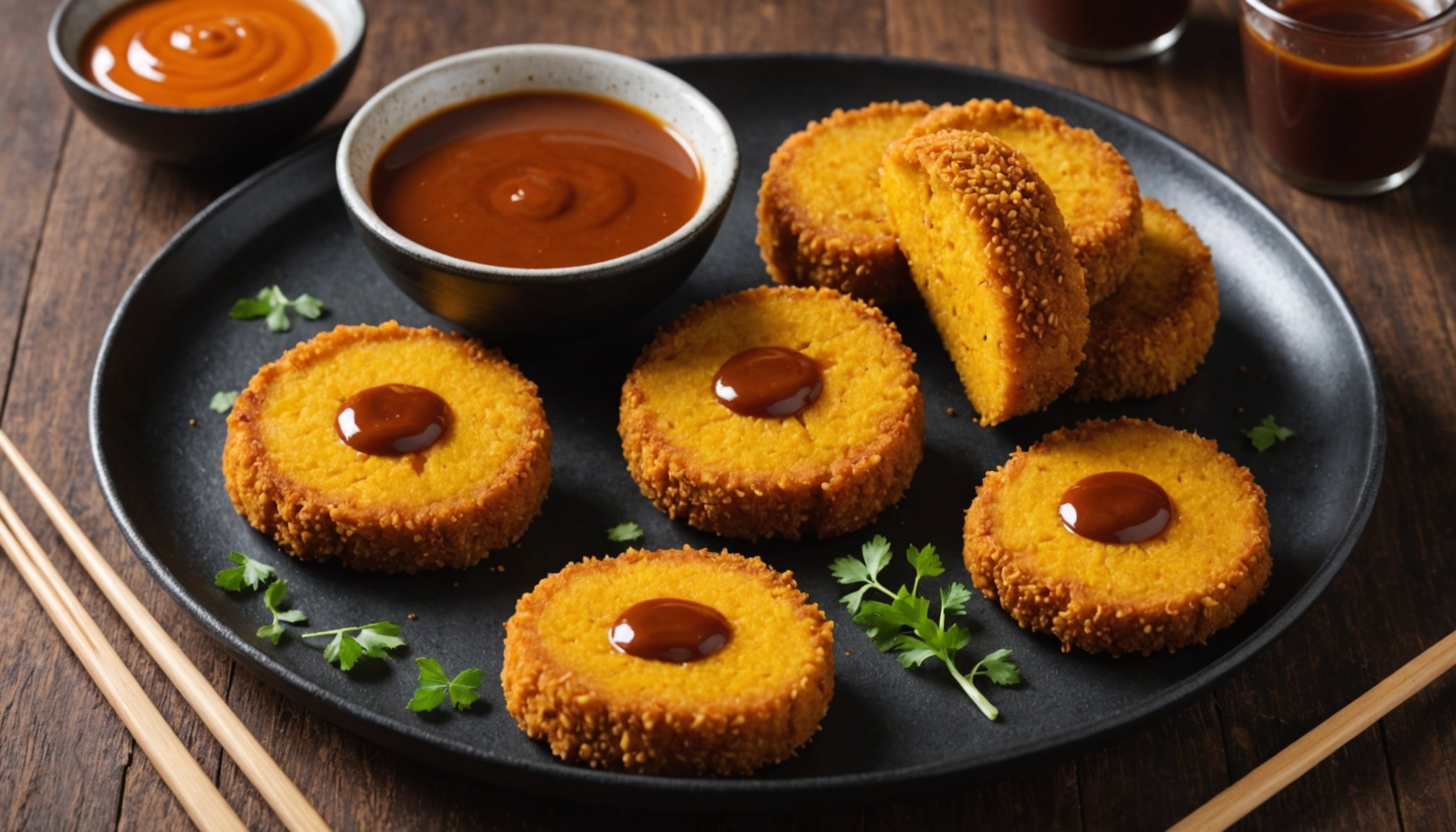Overview of Japanese Pumpkin Korokke
Japanese pumpkin korokke, a delightful Japanese dish, is a type of croquette made by incorporating the unique flavors of kabocha, or Japanese pumpkin. Korokke itself, derived from the French croquette, made its way into Japanese cuisine in the late 19th century. The dish traditionally includes mashed potatoes or, alternatively, the sweet and earthy kabocha, enhancing its texture and flavor.
The substitution of kabocha in Japanese pumpkin korokke is significant. Unlike regular potatoes, kabocha offers a creamy and slightly sweet profile that enriches the dish. Its bright orange flesh holds together well, making it ideal for frying, which is a key aspect of korokke preparation. This choice of ingredient not only diversifies the flavor but also highlights the versatility of Japanese pumpkins in culinary practices.
Also to read : Unveiling the secrets of the burger king mystery box
Culturally, korokke holds a special place in Japanese society. It’s a familiar staple in home cooking and a popular item in bento boxes, emphasizing its role as a comforting and practical meal option. Korokke’s accessibility makes it a favorite across many households, symbolizing warmth and a home-cooked touch. Furthermore, its adaptability to include different core ingredients like kabocha exemplifies the innovation present in Japanese cooking traditions.
Ingredients for Perfect Pumpkin Korokke
Creating a delicious pumpkin korokke begins with selecting the right ingredients and enhancing their natural flavors. Understanding the essentials and experimenting with enhancements can yield a memorable dish.
Additional reading : Unlocking the Art of a Luxuriously Creamy Mascarpone and Fig Cheesecake: Secrets Revealed!
Essential Ingredients
Korokke ingredients generally include mashed pumpkin, flour, and panko breadcrumbs for that classic crispy coating. The inclusion of an egg ensures a perfect binding of the mixture. Salt and pepper are simple yet crucial for foundational seasoning. A touch of milk can create a creamy texture without overpowering the pumpkin’s natural sweetness.
Recommended Pumpkin Varieties
Choosing the right pumpkin is vital for achieving the desired taste and texture. Varieties like Kabocha or Butternut squash are highly recommended. These types bring a naturally sweet and rich flavor, which is perfect for korokke. Kabocha has a dense, nutty flavor, while Butternut squash offers a creamy, smooth texture. These qualities help in crafting a harmonious blend with other ingredients.
Additional Flavor Enhancers
To further refine your korokke, consider using flavor enhancers. Spices like nutmeg or cinnamon can enrich the pumpkin’s natural sweetness. For a slight kick, consider adding a pinch of cayenne pepper. Herbs such as thyme or sage complement the pumpkin nicely, adding depth and complexity to the dish without overshadowing the primary flavors.
Step-by-Step Recipe for Japanese Pumpkin Korokke
Creating Japanese Pumpkin Korokke at home is a delight, and with the right cooking method, it can be both fun and rewarding. To start, choose a quality Japanese pumpkin, also known as kabocha, for its sweet taste and firm texture. Begin by peeling and chopping the pumpkin, then steaming or boiling until soft enough to mash.
Once the pumpkin is tender, mash it thoroughly to achieve a smooth consistency. Preparation tips proclaim that adding a pinch of salt or pepper enhances the flavor.
Next, focus on crafting and forming the korokke. Shape the mashed pumpkin into small, round patties. For the optimal crispiness in your korokke, ensure each piece is evenly sized. For breading, follow the essential steps: coat each patty lightly in flour, dip in beaten egg, and roll in Panko breadcrumbs. This technique guarantees a lovely golden crust.
The final touch is frying. Deep frying is recommended for the best texture; use oil heated to approximately 170°C (340°F) for an even, crunchy exterior. Cook until they are beautifully golden brown. Alternatively, shallow frying with careful monitoring can achieve similarly excellent results with slightly less oil.
Embrace the traditional korokke with these steps and enjoy the crisp, savory pleasure at home.
Mastering Tonkatsu Sauce
Creating a homemade tonkatsu sauce offers a unique opportunity to explore its rich, savory profile and master its ideal pairings.
Ingredients for Tonkatsu Sauce
To craft this quintessential Japanese condiment, start with readily available ingredients. Typically, you’ll need:
- Ketchup for its sweet and tangy base
- Worcestershire sauce adds depth and complex flavor
- Soy sauce contributes umami and saltiness
- Sugar for balancing acidity
- Mirin introduces a subtle sweetness and depth
Adjusting these ingredients allows customization to align with personal taste preferences.
Step-by-Step Guide to Making Sauce
Begin by combining the ketchup, Worcestershire sauce, and soy sauce in a saucepan. Warm the mixture over medium heat while stirring continuously to dissolve the sugar. Gradually incorporate mirin, ensuring it blends smoothly. Allow the sauce to simmer gently until it thickens to the desired consistency. Once cooled, it’s ready for use.
Pairing Suggestions
Well-crafted tonkatsu sauce can transform a simple dish into a delight. Particularly, it complements the crispy exterior and tender interior of korokke. The sauce’s robust flavor pairing enhances the homemade croquette’s layers, resulting in a satisfying culinary experience. Explore additional pairings or experiment with other fried dishes to broaden your taste palate.
Plating and Serving Suggestions
Enhancing the visual appeal of your korokke through creative plating can elevate your dining experience. Consider using different serving ideas to make your meal stand out. For instance, you could place korokke on a bed of fresh greens or drizzle with a vibrant sauce for an artistic touch. Arranging them neatly on a slate or wooden board can also add a rustic charm.
When it comes to meal pairing, the possibilities are diverse. Side dishes that complement korokke can truly round off your plate. A crisp salad with a tangy vinaigrette can balance the richness of korokke, providing fresh and sharp flavors that cut through the fried exterior. Another classic pairing is steamed rice, which adds a neutral, comforting base to the meal.
Balancing flavors and textures on the plate is crucial. To achieve this, consider the contrast of textures: the crispy exterior of korokke paired with smooth mashed potatoes or a creamy dip can create an interesting bite. Additionally, think about infusing a range of flavors, such as sweet, salty, and umami, for depth and richness.
In summary, by utilizing creative presentation techniques and thoughtful meal pairings, your korokke dishes can become not only delicious but a feast for the eyes.
Troubleshooting Common Issues
When diving into cooking tips for korokke, it’s important to anticipate potential pitfalls. Many enthusiasts find themselves facing some common mistakes that can easily be rectified with a touch of know-how and practice.
Common Problems and Solutions
Korokke can sometimes turn out greasy or soggy, which is often a result of not heating the oil properly. To ensure a perfect crisp, heat oil to 180°C. If the mixture falls apart during frying, consider mixing in more panko breadcrumbs or egg to bind ingredients effectively. Finally, ensure your potatoes are adequately mashed and drained to avoid excess moisture that might compromise texture.
Recipe Variations
Catering to different dietary needs or taste preferences can lead to interesting recipe variations. Swap out traditional potatoes for sweet potatoes or add minced chicken for a protein boost. For those with gluten sensitivities, consider using gluten-free breadcrumbs. Adding spices like curry powder or herbs can enhance flavor, offering a unique twist to the classic dish.
Tips for Perfecting Texture
Achieving flawless texture involves a few key techniques. Always ensure your korokke is uniformly sized to guarantee even frying. To maintain the right texture, allow the mixture to chill slightly before shaping and frying. The breadcrumb coating should also be generous yet delicate, providing that satisfying crunch with each bite.
Additional Resources and Visual Aids
In the world of cooking, visual aids significantly enhance understanding and execution. These aids serve not just beginners but seasoned chefs too, offering a framework that simplifies intricate cooking processes. Engaging with cooking videos can transform how you approach cooking, providing a step-by-step visual guide that transcends the limitations of text descriptions.
Recipe cards are another crucial resource. They can condense complex recipes into easy-to-follow steps. Designed to be a quick reference, these cards highlight necessary ingredients, prep time, and cooking techniques, offering a concise guide to follow while cooking. The visual design of these cards plays a pivotal role in helping users grasp the sequence and timing.
For those seeking a more interactive approach, visual tutorials provide an immersive experience. These are often found as online classes or video series, guiding viewers through every detail of a recipe. They can illustrate the precise cutting techniques or the exact consistency of a sauce, aiding in the achievement of perfect results.
Infographics serve as excellent quick-reference tools. They break down cooking steps, highlight potential pitfalls, and offer tips. Although this section can’t provide direct links, websites like Pinterest are treasure troves for such visual resources, ensuring you have all the information at your fingertips.











